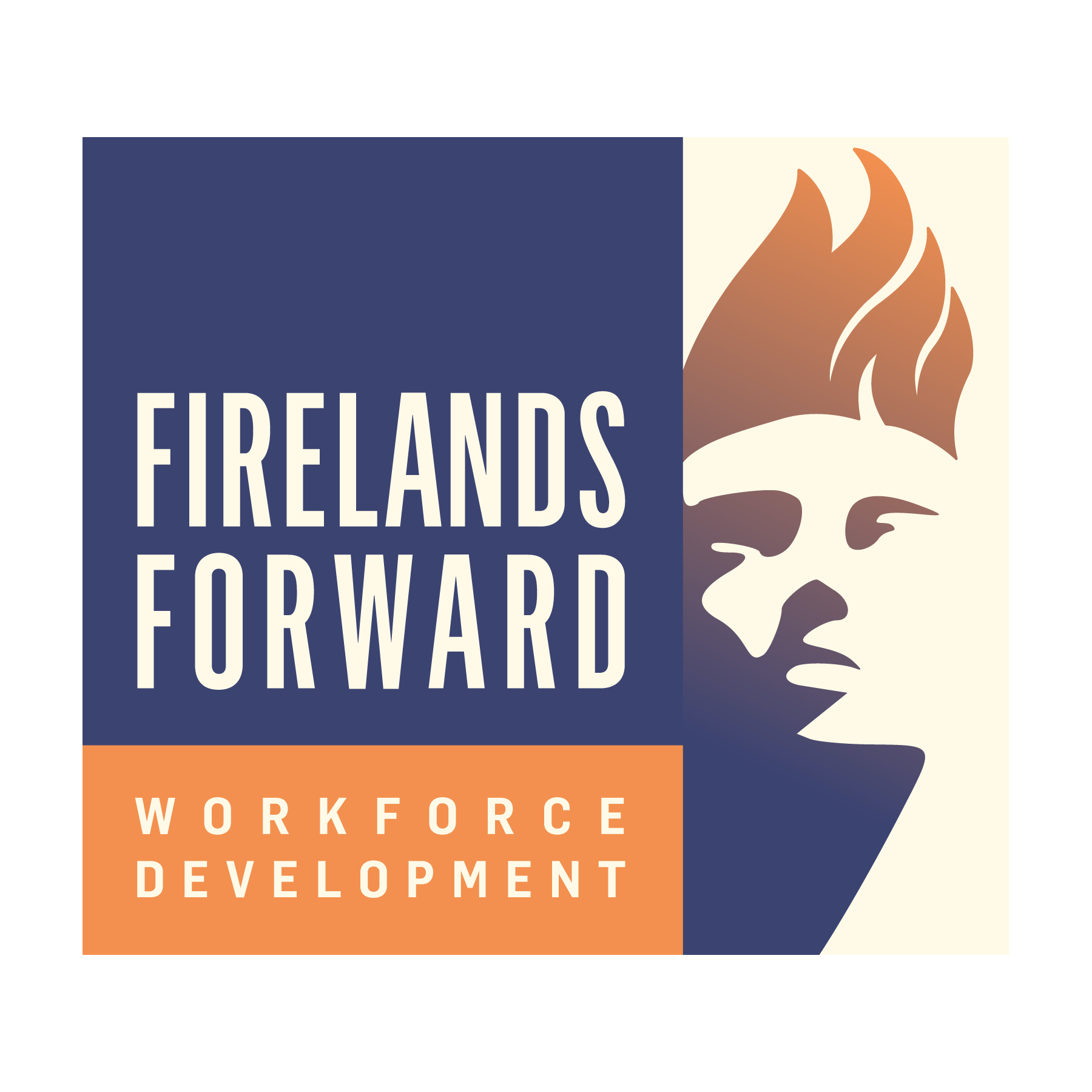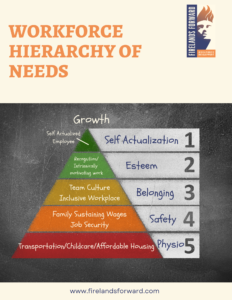The complexity of the workforce landscape demands an integrated and tiered approach to begin to address the many underlying causes of low labor force participation. Firelands Forward created the Workforce Hierarchy of Needs (based off of Maslow’s Hierarchy of Needs) to articulate the dynamics of this intricate environment. If employers aim to develop a strategy around addressing the labor shortage, it is important to understand that wages are not the only factor driving this phenomenon. Nor is this a simple fix that will right itself overnight. At the base of the hierarchy lies workers physiological needs. This encompasses what framework needs to be in place in order to enable employees to go to work, things like transportation, affordable housing, and childcare. It is not until these basic needs are met that a job seeker can even apply for a job. As an employer (and community in some instances) creates an environment in which the employee can move upward in the hierarchy, the ability to attract a workforce increase, the ability to retain a workforce increases, and ultimately the ability to increase production and create an opportunity for growth occurs.
Nico:
Understanding the basic needs people must have to be able to work is such a necessary conversation. I doubt this problem has been viewed through this lens before. We usually think, people have to work if they want to have a good standard of living and while that might be true, it still doesn’t answer the question as to why our labor force participation rate is in the low 60’s. This might be the first step to better understand and addressing this critical problem. If I am reading this correctly, this is a roadmap for businesses to attract and retain the employees they need to be successful.
David:
Nico, I think that it is a roadmap to business growth that employers, community leaders, and voters all should pay attention to. Businesses alone can’t solve everything. The workforce’s physiological needs like transportation and affordable housing should be addressed through collaboration between public and private partners (going back to our public/private partnership discussion). There are steps, however; that businesses can take to address some of these basic needs. Benefit packages are going to start to look different in the near future. Businesses can, and may need to, subsidize childcare and transportation for their employees. There are multiple ways to do this. There are FSA like accounts that employers can contribute to. This can be in place of some or all of their 401k contribution if needed in order to ensure fairness for employees that don’t need the subsidy. This allows employees to contribute pre-tax dollars while also allowing the employer to subsidize these basic needs. Again, if basic needs aren’t being met, it is hard for Asset Limited Income Constrained but Employed (ALICE) workers to think about retirement. However, that is just one potential solution out of dozens. Employers will need to get innovative to develop customized plans to attract laborers to their companies. What has always worked, will not be what works in the future and we need to start to get used to that.
Nico:
Collaboration between the various stakeholders will be essential. If this roadmap is going to be systemized in business, these stakeholders will need to be in synch to decide the most effective processes and programs that will help move people up the pyramid. The idea of using various subsidies and tax benefits would be a great step in the right direction to help mitigate the costs on the businesses. As we explore this topic further, I’ll be interested in what other unique ideas can come together to help overcome some of these initial barriers.
David:
Nico, I think at the end of the day businesses must conduct a cost analysis between the cost of turnover or reduced productivity and subsidizing workforce needs. I also believe the stakeholders change as you move towards a self-actualized employee. The base of the pyramid requires civil and business leaders as well as individual employees and their families. As an employee moves towards self-actualization, civil leaders play less of a role. While company policy is still important, individual managers and an employee’s growth mindset become more and more critical. For example, if a company provides family sustaining wages, a public-private partnership exists to reduce the cost of transportation, and there is an onsite childcare facility, but the organization has bad managers, the business may retain its employees but will unlikely experience growth because an unhealthy culture will stifle innovation.
Nico:
That is such an important understanding. As employees look to move up the pyramid the responsibility and influence shifts. Understanding where and who plays a significant role will help all those involved understand when and how their influence is essential and to what extent it is needed. Businesses that can understand this path and create systems to help map it for individual employees will find a lot of success not only in retention but in productivity. You mentioned what it looks like initially and what can hinder further growth as they move up, but what systems can businesses put in place to help employees reach the top?
David:
Great question, and one that doesn’t come with a simple answer. I’ll give some thoughts but certainly not an all-inclusive list. Defining career pathways and promotional pathways for employees is important. If an employee can visualize the path to success, he or she is much more likely to be fulfilled in working to get there. Good leadership and culture are also critical. This doesn’t happen without a deliberate approach to build culture and a defined professional development model for leader development. Hiring the right employees in all roles, but specifically ones that lead teams is also a critical component. It is helpful for all employees to see the why they do but it is essential for leaders to live it and reinforce it. Again, not an all-inclusive list, but one that highlights role shifts in different rungs of the ladder.
David White
Director, Firelands Forward
Nico Samaniego
Business Development Coordinator, ECEDC
Firelands Forward: 247 Columbus Avenue, Sandusky, OH, United States, Ohio

